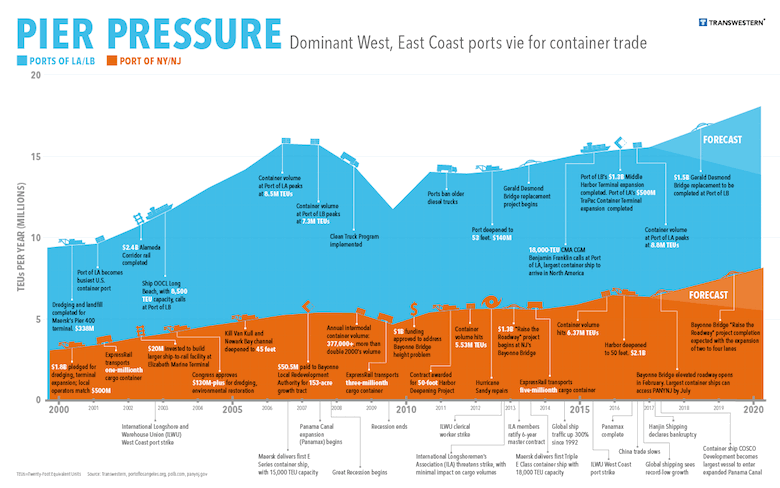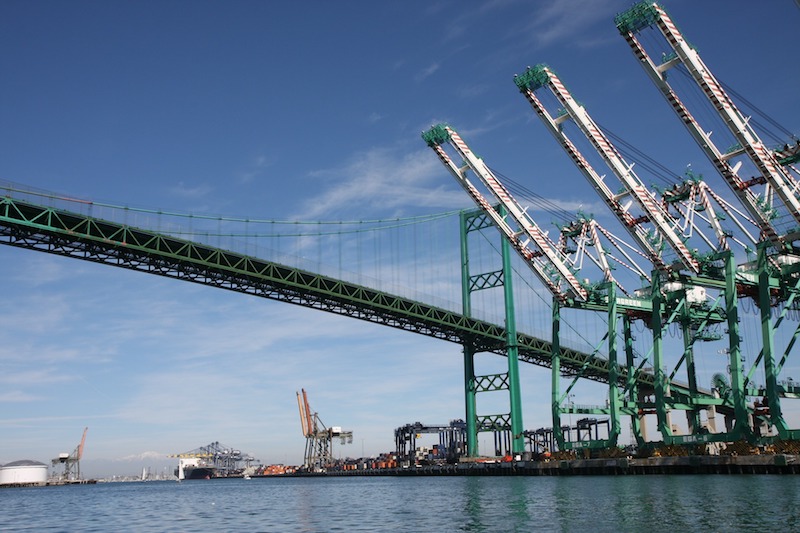The $5 billion Panama Canal expansion (Panamax) opened in late June 2016, making direct access of larger ships from China and elsewhere to America’s East Coast ports more expedient.
But well before that opening, three dominant U.S. ports were engaged in large-scale growth efforts to hold onto and increase their share of that anticipated container trade.
Ports of Los Angeles and Long Beach, Calif., and the Port of New York and New Jersey have spent the past two decades deepening channels, raising bridges, and investing in terminal automation and dockside infrastructure (see chart).
Since Panamax opened, the Port of Long Beach has completed a $1.3 billion Middle Harbor Terminal expansion; and the Port of Los Angeles—whose container volume peaked this year at 8.8 million Twenty-Foot Equivalent Units (TEUs)—completed a $500 million TraPac Container Terminal Expansion.
The Port of New York/New Jersey spent $2.1 billion to deepen its harbor to 50 feet. And by opening an elevated Bayonne Bridge, the largest container ships now have access to the Port of NY/NJ.
CLICK IMAGE TO ENLARGE
 This chart shows the relationship between the development and construction actvities at America's three largest ports— Los Angeles, Long Beach and New York/New Jersey—and their increases in container volumes. Image: Transwestern.
This chart shows the relationship between the development and construction actvities at America's three largest ports— Los Angeles, Long Beach and New York/New Jersey—and their increases in container volumes. Image: Transwestern.
Despite predictions that the Panama Canal widening would disseminate some shipping away from major ports to an array of smaller markets on the Gulf and East Coasts, the ports of Los Angeles and Long Beach and Port of NY/NJ “have retained their stature as the dominant entry points for containerized merchandise and manufacturing components to be assembled domestically,” observe two executives from Transwestern, the national real estate firm.
In its recent edition of “Ask the Expert,” Transwestern’s Director of Research for New Jersey Matthew Dolly and Research Manager for Southern California Michael Soto point out that, as activity at these ports increases, rent rates have been rising, but still take a back seat to transportation costs and access to labor as factors determining where businesses select space.
Panamax has caused some shifts in where ships from Asia and elsewhere unload in the U.S. The Ports of Long Beach and Los Angeles, America’s two largest ports, once received half of all containerized goods entering the U.S. Last year they handled a combined 15.6 million TEUs, or just under one-third of national volume. The authors state that these ports’ combined volume is projected to increase by 3.9% annually through 2040.
The Port of NY/NJ recognized opportunities from increasing shipping travel through the Suez and Panama Canals. Last year, its annual volume peaked to 6.25 million TEUs, or 13% of U.S. volume, and became America’s third-largest port. The authors say that this port has been “catching up” to its West Coast competitors.
In general, busy ports are catalysts for industrial and commercial development around them. This is even truer now that several ports have positioned themselves to receive higher container volumes from giant ships.
About one-third of containerized cargo entering the L.A and Long Beach ports stays in the region to serve 20 million local consumers. And given New York and New Jersey’s population density, they are lucrative destinations for imported goods, many of which travel through the Suez Canal.
“As the world’s concentration of low-cost labor shifts from China to India and other markets bordering the Indian Ocean, the volume of goods passing through the Suez Canal to enter the U.S. via East Coast ports will likely increase,” the Transwestern authors write.
Warehouse and distribution spaces on both coasts are at a premium. And, say the authors, it appears that retailers and manufacturers seem willing to accept higher rents to be closer to those distribution points nearer the ports. “Developers must decide how far away from the region’s population center they can build before the distance makes a location impractical for distribution centers,” the authors write.
The ports in southern California and the New York metro region have committed to maintaining and improving their surrounding infrastructures to be able to handle the transportation of high cargo volumes. Last year, for example, New Jersey’s Transportation Trust Fund earmarked $400 million in annual funding for road, bridge and transit improvements.
In Southern California, major infrastructure improvements include the $1.5 billion replacement of the Gerald Desmond Bridge in Long Beach, to allow access to the port for the tallest container shops. The new bridge will have six lanes (two more than the existing span), as well as a bike lane and observation deck. It’s scheduled for completion next year, at which point it will span 8,800 feet.
Related Stories
| Oct 13, 2010
Community college plans new campus building
Construction is moving along on Hudson County Community College’s North Hudson Campus Center in Union City, N.J. The seven-story, 92,000-sf building will be the first higher education facility in the city.
| Oct 12, 2010
Building 13 Naval Station, Great Lakes, Ill.
27th Annual Reconstruction Awards—Gold Award. Designed by Chicago architect Jarvis Hunt and constructed in 1903, Building 13 is one of 39 structures within the Great Lakes Historic District at Naval Station Great Lakes, Ill.
| Sep 13, 2010
World's busiest land port also to be its greenest
A larger, more efficient, and supergreen border crossing facility is planned for the San Ysidro (Calif.) Port of Entry to better handle the more than 100,000 people who cross the U.S.-Mexico border there each day.
| Aug 11, 2010
JE Dunn, Balfour Beatty among country's biggest institutional building contractors, according to BD+C's Giants 300 report
A ranking of the Top 50 Institutional Contractors based on Building Design+Construction's 2009 Giants 300 survey. For more Giants 300 rankings, visit http://www.BDCnetwork.com/Giants
| Aug 11, 2010
Jacobs, Arup, AECOM top BD+C's ranking of the nation's 75 largest international design firms
A ranking of the Top 75 International Design Firms based on Building Design+Construction's 2009 Giants 300 survey. For more Giants 300 rankings, visit http://www.BDCnetwork.com/Giants
| Aug 11, 2010
Steel Joist Institute announces 2009 Design Awards
The Steel Joist Institute is now accepting entries for its 2009 Design Awards. The winning entries will be announced in November 2009 and the company with the winning project in each category will be awarded a $2,000 scholarship in its name to a school of its choice for an engineering student.
| Aug 11, 2010
SSOE, Fluor among nation's largest industrial building design firms
A ranking of the Top 75 Industrial Design Firms based on Building Design+Construction's 2009 Giants 300 survey. For more Giants 300 rankings, visit http://www.BDCnetwork.com/Giants
| Aug 11, 2010
Best AEC Firms of 2011/12
Later this year, we will launch Best AEC Firms 2012. We’re looking for firms that create truly positive workplaces for their AEC professionals and support staff. Keep an eye on this page for entry information. +
| Aug 11, 2010
Clark Group, Mortenson among nation's busiest state/local government contractors, according to BD+C's Giants 300 report
A ranking of the Top 40 State/Local Government Contractors based on Building Design+Construction's 2009 Giants 300 survey. For more Giants 300 rankings, visit /giants










